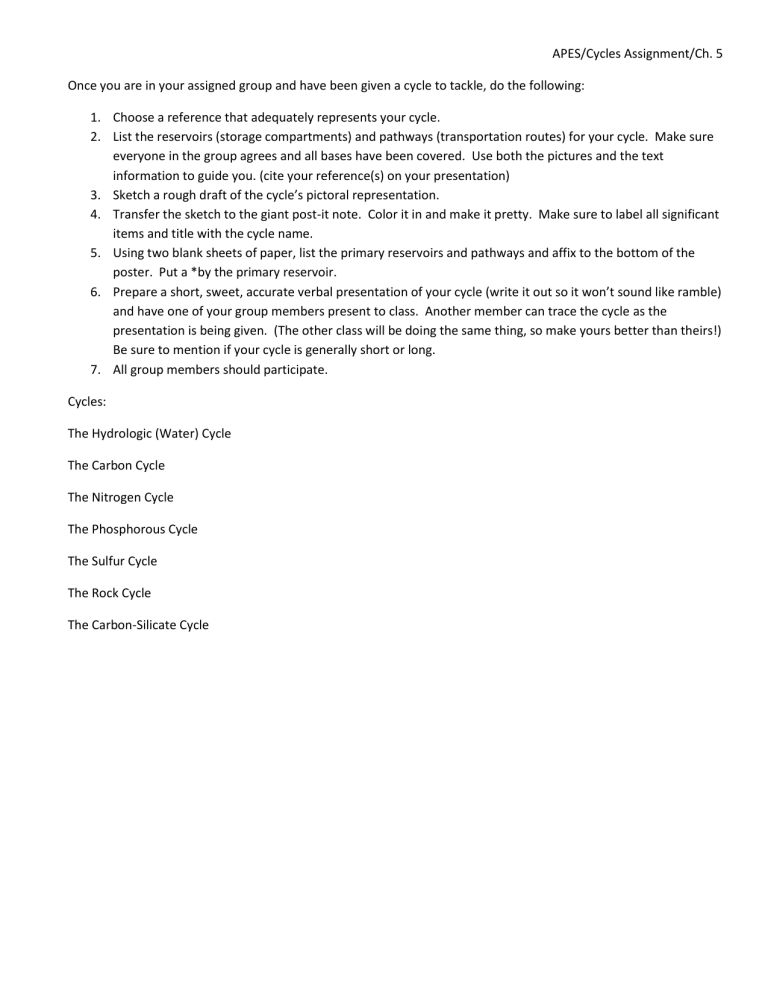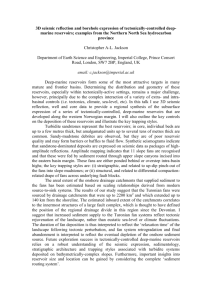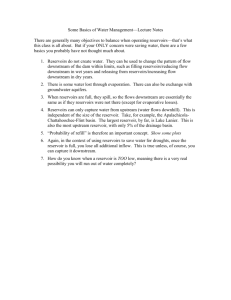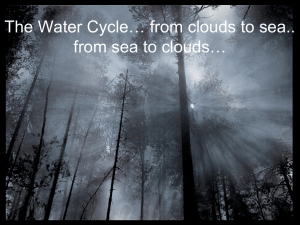APES/Cycles Assignment/Ch. 5 Once you are in your assigned

APES/Cycles Assignment/Ch. 5
Once you are in your assigned group and have been given a cycle to tackle, do the following:
1.
Choose a reference that adequately represents your cycle.
2.
List the reservoirs (storage compartments) and pathways (transportation routes) for your cycle. Make sure everyone in the group agrees and all bases have been covered. Use both the pictures and the text information to guide you. (cite your reference(s) on your presentation)
3.
Sketch a rough draft of the cycle’s pictoral representation.
4.
Transfer the sketch to the giant post-it note. Color it in and make it pretty. Make sure to label all significant items and title with the cycle name.
5.
Using two blank sheets of paper, list the primary reservoirs and pathways and affix to the bottom of the poster. Put a *by the primary reservoir.
6.
Prepare a short, sweet, accurate verbal presentation of your cycle (write it out so it won’t sound like ramble) and have one of your group members present to class. Another member can trace the cycle as the presentation is being given. (The other class will be doing the same thing, so make yours better than theirs!)
Be sure to mention if your cycle is generally short or long.
7.
All group members should participate.
Cycles:
The Hydrologic (Water) Cycle
The Carbon Cycle
The Nitrogen Cycle
The Phosphorous Cycle
The Sulfur Cycle
The Rock Cycle
The Carbon-Silicate Cycle
APES/Ch. 5/Cycle Notes (source: AP Bio Book, Raven & Berg, Botkin & Keller)
The Hydrologic (Water) Cycle (controls decomposition rates)
Reservoirs ocean glaciers polar ice caps lakes rivers groundwater atmosphere
Pathways precipitation evaporation condensation percolation (infiltration) runoff transpiration
The Carbon Cycle (present in organic molecules essential to all organisms)
Reservoirs
Fossil fuels
Soil
Sediment (aquatic)
Ocan
Plants
Animals
Atmosphere
Rocks (limestone) detritus
Pathways
Combustion of fossil fuels
Photosynthesis (in) (plants and phytoplankton)
Respiration (out)
Volcanic eruptions decomposition
The Nitrogen Cycle (component of amino acids, proteins, and nucleic acids/often limiting plant nutrient)
Plants and Algae: use NH
4
+ and NO
3
-
Bacteria: NH
4
+ , NO
3
, NO
2
-
Animals: store in amino acids and proteins
Reservoirs
*atmosphere soils sediments of lakes, rivers, and oceans dissolved in surface water dissolved in groundwater biomass of living organisms nitrogen fertilizer blowing dust bacteria
Pathways
Nitrogen fixatioin
Nitrification
Ammonification
Assimilatioin denitrification
The Phosphorous Cycle (nucleic acids, phospholipids, ATP (E storage) plus find in bones and teeth)
Plants use: PO
4
3 (absorb it and use to synthesize organic compounds)
Reservoirs sedimentary rocks (marine sediment) soils ocean (dissolved in) organisms guano
Pathways weathering of rock
Llaching of groundwater & surface water through food web (consumers) decomposition of biomass excretion by consumers precipitation (aids weaterhing process) geologic uplift runoff plant uptake
The Sulfur Cycle (tiny fraction in living organisms, but is essential to proteins)
Cycle is driven by bacteria.
Plant roots: absorb SO
4
2 (plant protein, DSM (CH
3
SCH
3
) released by marine algae)
DSM helps condense water droplets in clouds. It the atmosphere, it is converted to SO
4
2 and deposited into oceans
Reservoirs soil (metallic sulfides) rock (sedimentary) atmosphere animals and plants ocean detritus
Pathways wet depositioin dry deposition combustioin decomposition weathering erosion runoff sea spray forest fires dust storms volcanoes (H
2
S, SOx)
Rock Cycle
Reservoirs igneous rocks metamorphic rocks sedimentary rocks sediment volcanoes
Pathways deposition lithification weathering erosion melting metamorphism freezing techtonic uplift
Carbon-Silicate Cycle
Reservoirs
Atmosphere
Carbonate-rich sediment
Marine organisms (Ca 2+ and HCO
3
used in shells)
Magma (CO
2
)
Pathways
Precipitation (H
2
CO
3
)
Techtonic cycle (delivers CO
3
2 sediment to subduction zone
Volcanic eruptions






